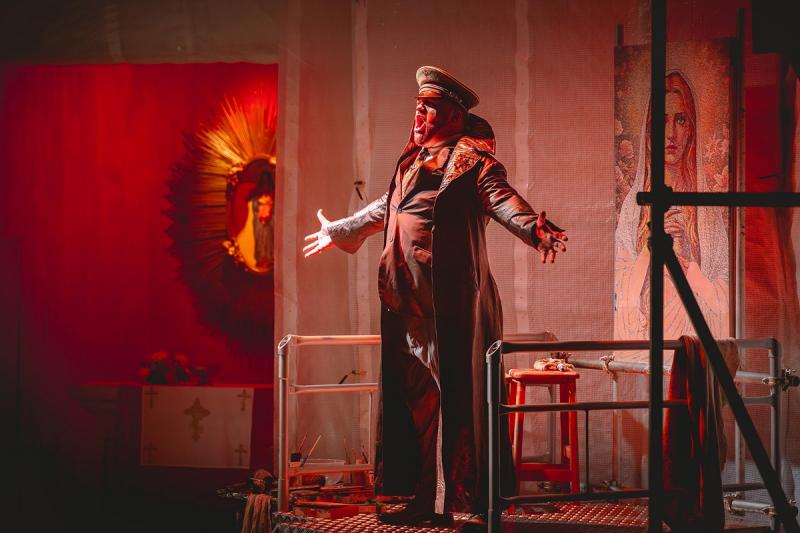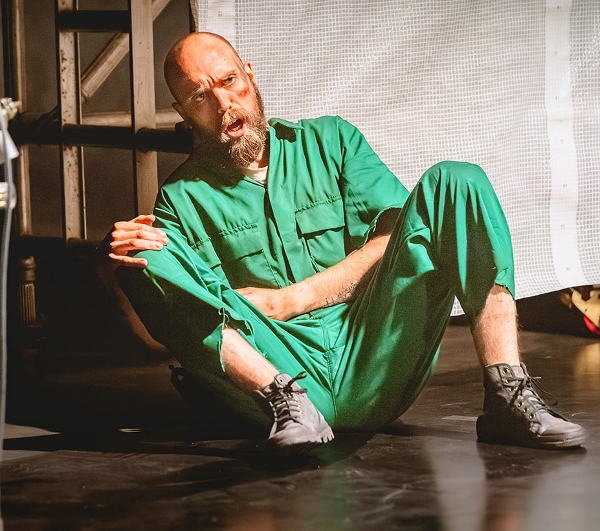Tosca, Clonter Opera review - beauty and integrity in miniature | reviews, news & interviews
Tosca, Clonter Opera review - beauty and integrity in miniature
Tosca, Clonter Opera review - beauty and integrity in miniature
Happy surprises and a convincing interpretation of Puccini for today

At first sight, it seemed that Clonter Opera’s decision to tackle Tosca this year might be a leap too far. Its once-a-year complete production, dedicated to nurturing emerging talent in the security of the Cheshire countryside, must always be an essay in miniaturization, and a singing cast of six and an orchestra of 12 might seem hopelessly small for Puccini’s grand passions and shuddering shocks.
In the end, it was a happy surprise that so much of beauty and musical integrity emerged from the exercise – and that the production by Steve Elias brought a convincing fresh interpretation to the drama. When Clonter did Hansel and Gretel (some years ago), I remember being astonished that Humperdinck’s lush orchestration turned out to be fresh and almost like a new chamber-sized creation when reduced to a handful of players. The reason was that the composer’s textures and counterpoint were so soundly crafted in true Germanic tradition that every note played its part and harmonic logic never departed.
Puccini is not like that: his writing can be garishly colourful and near-impressionistic – and relies on sheer weight of tone for effect in many of its most telling and climactic moments. So the opening three chords, fff tutta forza, which are to be the grim symbol of sheer evil and its embodiment in the character of Scarpia throughout the opera, could never sound the same without a full orchestra (and a big bass drum!).
And yet the stripping away of lushness and paring of the score down to the barest essentials, in the ingenious reduction by Jonathan Lyness, has its rewards, and the Clonter Sinfonia, led by Liz Rossi, did their utmost to big it up whenever possible.  There was another issue, peculiar to one night only, in the performance I attended. Konstantinos Akritides, who I found to be “a fine developing tenor” in his contribution to last year’s The Butterfly House (a Clonter-created music theatre life of Puccini, told with his own music), did not sing his role after three performances in four days but mimed it, with the voice of Martins Smaukstelis heard from the side of the stage (more on his fine contribution below). This was a collective decision, "due to the extraordinary vocal demands of this role ... this measure has been taken to preserve the vocal health of Mr Akritides, and ensure the highest quality for the remaining shows". There was a cover engaged, but he fell ill and the Latvian-born tenor stepped in at 24 hours’ notice. These things happen in opera, and perhaps Clonter will be wishing that they had double-cast the role of Cavaradossi, as they have with that of Floria Tosca – Emilie Cavallo sang her when I visited, but shared the task with Isabel Garcia Araujo.
There was another issue, peculiar to one night only, in the performance I attended. Konstantinos Akritides, who I found to be “a fine developing tenor” in his contribution to last year’s The Butterfly House (a Clonter-created music theatre life of Puccini, told with his own music), did not sing his role after three performances in four days but mimed it, with the voice of Martins Smaukstelis heard from the side of the stage (more on his fine contribution below). This was a collective decision, "due to the extraordinary vocal demands of this role ... this measure has been taken to preserve the vocal health of Mr Akritides, and ensure the highest quality for the remaining shows". There was a cover engaged, but he fell ill and the Latvian-born tenor stepped in at 24 hours’ notice. These things happen in opera, and perhaps Clonter will be wishing that they had double-cast the role of Cavaradossi, as they have with that of Floria Tosca – Emilie Cavallo sang her when I visited, but shared the task with Isabel Garcia Araujo.
So the spotlight inevitably fell on the two remaining big roles in the opera: Tosca herself, and Scarpia, who was sung by Robin Hughes (pictured above).
Emilie Cavallo, who sang in The Butterfly House in 2024, this time had the opportunity to take a full and taxing role, and showed herself to be a performer of real vocal quality as well as a gifted actress. Her tone is rounded and mature in mid-register, and was well sustained and beautifully tuned throughout. The production’s values curtail opportunities for flouncing as Tosca the diva, but she catches the vulnerability and sincerity of the role, which is the important part of it, really well, and never stops acting and reacting to the other protagonists. And her "Vissi d’arte" was sung as a kind of credo, pure and lovely to hear, and finally prayerful.
Robin Hughes is a very fine singer: keeping up the insistent menace and power in his voice and acting the character with all the repulsive, lecherous evil it requires – the more convincing for his being clearly young enough to be a formidable foe to Tosca. His presence on the stage dominates whenever he’s seen.
 Angelotti was Fionn Ó hAlmhain (pictured left), Clonter’s Sarastro in The Magic Flute in 2023, and again imposing and resonant in his singing. The Sacristan was Sebastian Stride, who also became Sciarrone, and Spoletta was Luke Horner: both roles requiring acting gifts as well as effective voices. Sebastian Stride has a comic gift, but wisely did not let it run away with him in the opening scenes. There was a touch of caricature, but it’s not a clown’s part, and he showed the fear that Scarpia struck into everyone – an important part of the drama. Spoletta may be just plain nasty, but Luke Horner made his cruelty believable. Both have well-developed, reliable voices.
Angelotti was Fionn Ó hAlmhain (pictured left), Clonter’s Sarastro in The Magic Flute in 2023, and again imposing and resonant in his singing. The Sacristan was Sebastian Stride, who also became Sciarrone, and Spoletta was Luke Horner: both roles requiring acting gifts as well as effective voices. Sebastian Stride has a comic gift, but wisely did not let it run away with him in the opening scenes. There was a touch of caricature, but it’s not a clown’s part, and he showed the fear that Scarpia struck into everyone – an important part of the drama. Spoletta may be just plain nasty, but Luke Horner made his cruelty believable. Both have well-developed, reliable voices.
Martins Smaukstelis has a very interesting voice quality, lyrical and flexible in "Recondita armonia" and capable of great nobility and passion in "E lucevan le stelle". Konstantinos Akritides, of course, was not heard by me but certainly showed that he could act his role: I believe his full performance would have been something very special.
The production relocates the time of the story to 2023 and Giorgia Meloni’s Italy – not an entirely new idea (Opera North’s last production but one re-set it in Berlusconi’s era of Forza Italia, which was not so different), but one that makes interesting parallels with the end of the 18th century. Indeed, it sets off the thought that Italian politics has been so often about the vicious pursuit of power that nothing has changed much.
So at the outset we see on-screen video clips of recent events, and later some video to illustrate a church service for the end of Act One, of Tosca rushing from her cantata performance to try to save Cavaradossi (the audio-visualas are by Steve Brookfield). The setting and costumes (design is by Stewart J Charlesworth, following Steve Elias’s concept) are present-day: mobile phones, a cordless vac for the Sacristan; the portrait Cavaradossi paints identified with the Attavanti by Tosca by flourishing a cover picture of Vogue; Scarpia’s pad a cold and minimalist version of luxury, with TV screen to relay video of the off-stage torture (important to play the right clips there!); the report of the outcome of the battle of Marengo shown as a TV news item; the finale Act beginning with a smuggled video of Angelotti (who’s transformed to be a fearless investigative journalist in this version) speaking to reveal that his determination will result in “a full archive uploaded to La Repubblica”.
The illusion of vast spaces required for the first and last acts (the interior of a very large church, and the open battlements of the Castel Sant’Angelo) are evoked by glimpses of what lies behind a stage-dominating set made up of scaffolding, steel fabrication and white tarpaulins – in Elias’s view, to symbolise the unseen dimensions of what lies beneath surface appearance. As he pointed out in a pre-performance interview, the story is all about four people who began their day with no possible concept of the suffering, betrayal, duplicity and murder that were to ensue in 24 hours’ time.
Lighting design is by Tony Simpson, and very useful, and there is a kind of visual theme of blood-red colouring that becomes more apparent as the narrative proceeds – and the tragedy ends in a suitably overwhelming barrage of haze and light effects. The surtitles have been doctored “to serve the narrative of our production”, and occasionally this bumps up against the original’s references, but it still works well. The acting direction is detailed, as well it might be from the man who was Clonter’s movement director for The Magic Flute in 2023, and in this respect Steve Elias’s debut as director of a full opera production is impressive indeed. The action of Act Two was particularly well envisaged – both believable in the brutality and suitably bloody at the end.
Musical direction is by Philip Sunderland, already distinguished at Clonter in his 2021 Barber of Seville, his 2023 Magic Flute and in 2024 The Butterfly House. Of course, he’s had to make compromises here: the Te Deum in Act One is heard on the PA system, not live – and though he has an electronic organ at his fingertips, it is a relatively minor element in the sound tapestry – as is Tosca’s off-stage “cantata” voice in Act Two and the shepherd’s song in Act Three. But the more delicate and intimate passages in the score (and there are many) are beautifully done.
rating
Explore topics
Share this article
The future of Arts Journalism
You can stop theartsdesk.com closing!
We urgently need financing to survive. Our fundraising drive has thus far raised £49,000 but we need to reach £100,000 or we will be forced to close. Please contribute here: https://gofund.me/c3f6033d
And if you can forward this information to anyone who might assist, we’d be grateful.

Subscribe to theartsdesk.com
Thank you for continuing to read our work on theartsdesk.com. For unlimited access to every article in its entirety, including our archive of more than 15,000 pieces, we're asking for £5 per month or £40 per year. We feel it's a very good deal, and hope you do too.
To take a subscription now simply click here.
And if you're looking for that extra gift for a friend or family member, why not treat them to a theartsdesk.com gift subscription?
more Opera
 BBC Proms: The Marriage of Figaro, Glyndebourne Festival review - merriment and menace
Strong Proms transfer for a robust and affecting show
BBC Proms: The Marriage of Figaro, Glyndebourne Festival review - merriment and menace
Strong Proms transfer for a robust and affecting show
 BBC Proms: Suor Angelica, LSO, Pappano review - earthly passion, heavenly grief
A Sister to remember blesses Puccini's convent tragedy
BBC Proms: Suor Angelica, LSO, Pappano review - earthly passion, heavenly grief
A Sister to remember blesses Puccini's convent tragedy
 Orpheus and Eurydice, Opera Queensland/SCO, Edinburgh International Festival 2025 review - dazzling, but distracting
Eye-popping acrobatics don’t always assist in Gluck’s quest for operatic truth
Orpheus and Eurydice, Opera Queensland/SCO, Edinburgh International Festival 2025 review - dazzling, but distracting
Eye-popping acrobatics don’t always assist in Gluck’s quest for operatic truth
 MARS, Irish National Opera review - silly space oddity with fun stretches
Cast, orchestra and production give Jennifer Walshe’s bold collage their all
MARS, Irish National Opera review - silly space oddity with fun stretches
Cast, orchestra and production give Jennifer Walshe’s bold collage their all
 Káťa Kabanová, Glyndebourne review - emotional concentration in a salle modulable
Janáček superbly done through or in spite of the symbolism
Káťa Kabanová, Glyndebourne review - emotional concentration in a salle modulable
Janáček superbly done through or in spite of the symbolism
 Buxton International Festival 2025 review - a lavish offering of smaller-scale work
Allison Cook stands out in a fascinating integrated double bill of Bernstein and Poulenc
Buxton International Festival 2025 review - a lavish offering of smaller-scale work
Allison Cook stands out in a fascinating integrated double bill of Bernstein and Poulenc
 Tosca, Clonter Opera review - beauty and integrity in miniature
Happy surprises and a convincing interpretation of Puccini for today
Tosca, Clonter Opera review - beauty and integrity in miniature
Happy surprises and a convincing interpretation of Puccini for today
 Hamlet, Buxton International Festival review - how to re-imagine re-imagined Shakespeare
Music comes first in very 19th century, very Romantic, very French operatic creation
Hamlet, Buxton International Festival review - how to re-imagine re-imagined Shakespeare
Music comes first in very 19th century, very Romantic, very French operatic creation
 Falstaff, Glyndebourne review - knockabout and nostalgia in postwar Windsor
A fat knight to remember, and snappy stagecraft, overcome some tedious waits
Falstaff, Glyndebourne review - knockabout and nostalgia in postwar Windsor
A fat knight to remember, and snappy stagecraft, overcome some tedious waits
 Salome, LSO, Pappano, Barbican review - a partnership in a million
Asmik Grigorian is vocal perfection in league with a great conductor and orchestra
Salome, LSO, Pappano, Barbican review - a partnership in a million
Asmik Grigorian is vocal perfection in league with a great conductor and orchestra
 Semele, Royal Opera review - unholy smoke
Style comes and goes in a justifiably dark treatment of Handelian myth
Semele, Royal Opera review - unholy smoke
Style comes and goes in a justifiably dark treatment of Handelian myth
 Le nozze di Figaro, Glyndebourne review - perceptive humanity in period setting
Mostly glorious cast, sharp ideas, fussy conducting
Le nozze di Figaro, Glyndebourne review - perceptive humanity in period setting
Mostly glorious cast, sharp ideas, fussy conducting

Add comment